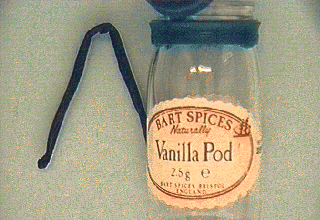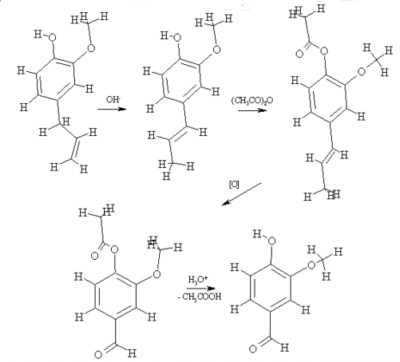 Vanilla pod.
Vanilla pod. When the Spanish conquistadores led by Hernan Cortes were in Mexico in 1520, one of their officers, Bernal Diaz, observed that the emperor Montezuma was drinking chocolatl, a beverage consisting of powdered cocoa beans and ground corn, flavoured with tlilxochitl (ground black vanilla pods) and honey.
 Vanilla pod.
Vanilla pod.
For more than three centuries after this, Mexico was the leading vanilla-producing country in the world despite attempts to plant the vines elsewhere.
Following the discovery of a technique for artificial pollination (about 1841) plantings were setup in Jamaica and other islands in the West Indies.
Vanillin, the crystalline component, was first isolated from vanilla pods by Gobley in 1858. By 1874 it had been obtained from glycosides of pine tree sap, temporarily causing an economic depression in the natural vanilla industry.
The plant (Vanilla planifolia) is a tropical orchid which grows as a vine and
needs the support of trees or poles whereupon it can reach a height of about 5 metres. The
flowers have a narrow bell surrounded by thin petals which develop slowly over several
months into long narow pods about 12-15 cm long. Vanilla needs a process of curing similar
to cacao to develop its characteristic aroma, for example the pods may be picked green
then sun dried, oven heated or cured in hot water.
During the curing process the flavour precursors, which are glucosides, are broken down
into vanillin and glucose and some other minor aromatic substances.
Vanilla extract is made by cutting the beans into small pieces and soaking in successive
quantities of hot 65-70% alcohol. Many commercial vanilla extracts are now actually blends
from natural and synthetic vanillin.
The "classical" synthesis of vanillin from
eugenol or iso-eugenol
was developed in 1896 and it remained the preferred method for about 50 years.
The scheme below is a sensitive map with links to the individual MDL mol files.

Vanillin is now prepared industrially in large amounts by the Reimer-Tiemann reaction,
starting with guaiacol (catechol monomethylether) from which it is formed along with o-vanillin.
Not all commercial vanillin is industrial?
Another source of vanillin is lignin, a byproduct of paper pulp manufacture.
A Mass Spectrum of vanillin in JCAMP-DX format is
available.
Return to links to the chemistry of other Jamaican items,
including spices and fruit and vegetables.
Created Feb 1995. Last modified 21st April-98.
URL http://wwwchem.uwimona.edu.jm:1104/lectures/vanilla.html